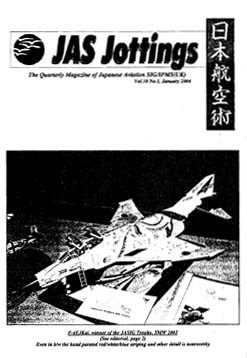 JAS
Jottings JAS
Jottings
The Quarterly Magazine Of The Japanese Aviation Special Interest Group/IPMS-UK
Vol. 10, No. 1, January 2004
The well illustrated and documented feature article in this issue is
a review of the design and operational history of the Kawasaki Ki-61 Hien.
It was given the Allied "McCoy" code name of "Tony" because, it is said,
Col. McCoy's staff thought it looked like a Macchi! I have a personal
interest in this subject because my first ever overseas trip was to Kawasaki's
Engine Plant in Akashi, Hyogo Prefecture for two weeks in early 1966 to
qualify them as an overhaul agent for Boeing. This is the plant where
the Daimler-Benz DB-601 was license built as the Kawasaki Ha-40 and where
they now build and overhaul jet engines. The Kawasaki motorcycles are
also built here and the WWII runway and taxi strip serve as the test track
for the bikes. Airframes were built at Gifu where Boeing 767 and 777 sections
are now built. Some large chunks of the 7E7 will also be built at Gifu.
The Ki-61 started with a heavier fighter design, the Ki-60, which did
not develop into a viable product. in the first part of this article the
author has had to get into the confusion surrounding Ki-61 designations
to clarify the situation. Most of this confusion was due to retroactively
changed, or applied, designations; editor Peter Starkings does an excellent
job of clarifying it all for us. As this article only takes us through
the development and use of "Tony" through the Ki-61-Id model, Peter will
continue in the next issue with the later developments of "Tony" through
to the end of the radial engined Ki-100 series the development of which
was made necessary by the Boeing B-29's having knocked out the Akashi
engine plant shutting of the supply of Ha-40 engines.
The kits and decals available in 1/72 and 1/48 scales are too quickly
commented upon and, it seems to me, some significant kits and decals are
missed.
The article ends with a summary of the units to which "Tonys" were
assigned and a comprehensive bibliography.
The second feature of this issue is on an altogether different subject
Japanese Military Airships 1910-1945. All of this was new to me and I
thought I knew a bit about Japanese aviation history! Fascinating. The
Airships are followed by a survey of the evolution of JAAF Trainers from
1910 through the surrender in 1945. More good stuff for us enthusiasts.
Japanese Aero Engines 1930-1945 continues with "Minor manufacturers" in
Part 10 and will continue further into, at least, the next issue. There
are then, too, the usual departments relating to book, decal and kit reviews
along with four color pages showing 11 photos of the J.A.S.D.F. Mitsubishi/Lockheed-Martin
XF-2A, XF-2B and F-2A; nee Convair F-16.
SIG membership is US$14 per four issue year. Contact the editor, Peter
Starkings, for details of payment. For US readers, he accepts US dollar
checks. You'll have to talk to him about payment in other currencies.
IPMS membership is not required but is recommended.
|
|